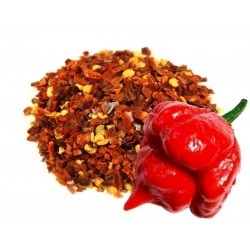Menu
-
MenuWstecz
- Home
-
Kategorie
-
-
Kategorie
-
Nasiona warzyw
-
Odmiany według kraju
- Odmiany z Armenii
- Odmiany z BiH
- Odmiany z Chorwacji
- Odmiany z Francji
- Varieties from Germany
- Varieties from Greece
- Varieties from Hungary
- Odmiany z Indii
- Varieties from Italy
- Odmiany z Japonii
- Odmiany z North Macedonii
- Varieties from Peru
- Varieties from Russia
- Varieties from Serbia
- Odmiany ze Słowenii
- Varieties from Spain
- Varieties from Thailand
- Odmiany z Turcji
- Varieties from USA
- Nasiona Pomidorów
- Nasiona kukurydzy
- Gurda rodziny
- Rodzina fasoli
- Nasiona Ogórka
- Nasiona Papryki
- Rodzina marchwi
- Rodzina cebuli
- Nasiona Sałaty
- Rodzina ziemniaków
- Rodzina kapuściana
- Nasiona Rzodkiewki
- Rodzina buraków
- Nasiona arbuza
- Nasiona melona
- Nasiona kalafiora
- Rodzina słoneczników
-
Odmiany według kraju
- Nasiona Owoców
- Nasiona Papryki Chili
- Nasiona ziół leczniczych
- Nasiona roślin pnących
- Drzewa - Krzewy - Nasiona
- Nasiona palmy
- Nasiona Traw Ozdobnych
- Nasiona tytoniu
-
Nasiona warzyw
-
-
-
-
- NOWE PRODUKTY
- Dostawa - płatność
- Utwórz konto
- FAQ
Lista produktów marki Seeds Gallery
Seeds produced by Seeds Gallery
Seeds produced by Seeds Gallery
Jest 408 produktów.
Pokazano 373-384 z 408 pozycji
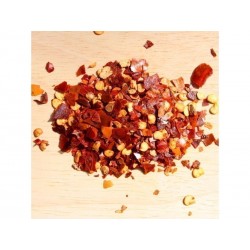
Trinidad moruga scorpion...
Cena
2,46 €
SKU: TMM 5g
Seeds Gallery Com,
5/
5
<!DOCTYPE html>
<html>
<head>
<meta http-equiv="Content-Type" content="text/html; charset=UTF-8" />
</head>
<body>
<h2><strong><em><span style="text-decoration: underline;"> <strong><em><span style="text-decoration: underline;">Trinidad moruga scorpion flakes Worlds Hottest</span></em></strong> </span></em></strong></h2>
<h3><span style="color: #ff0000;"><strong>Price for Package of 5 g.</strong></span></h3>
<p>The Trinidad Moruga Scorpion (Capsicum Chinense), endemic to the district of Moruga in Trinidad and Tobago, is currently the world's hottest Chili pepper cultivar. The New Mexico State University's Chili Pepper Institute has identified the Trinidad Moruga Scorpion as the newest hottest chili pepper in the world as of February 2012. According to the New Mexico State University Chili Institute, the Trinidad Moruga Scorpion ranks as high as 2,009,231 SHU on the Scoville scale, making it the hottest chili pepper in the world to date.</p>
<p>Paul Bosland, a renowned chili pepper expert and director of the Chili Institute, said that, "You take a bite. It doesn't seem so bad, and then it builds and it builds and it builds. So it is quite intense."</p>
<p>The golf ball-sized chili pepper scored the highest among a handful of chili cultivars reputed to be among the hottest in the world. Its mean heat topped more than 1.2 million units on the Scoville heat scale, while fruits from some individual plants reached 2 million heat units.</p>
<p>Leaving out the heat the Moruga Scorpion has a tender fruitlike flavor, which makes it a unique sweet-hot combination.</p>
<p><strong><em> Video:</em> <a href="http://www.youtube.com/watch?v=P2iWb6a8QD4" target="_blank" rel="noreferrer noopener">http://www.youtube.com/watch?v=P2iWb6a8QD4</a></strong></p>
<p><strong>Scoville ratings of peppers </strong></p>
<p><strong><a href="http://en.wikipedia.org/wiki/Trinidad_Moruga_Scorpion" target="_blank" rel="noreferrer noopener">http://en.wikipedia.org/wiki/Trinidad_Moruga_Scorpion</a></strong></p>
</body>
</html>
TMM 5g

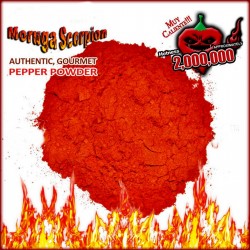
Trinidad moruga scorpion...
Cena
1,65 €
SKU: Z 6 TMP
Seeds Gallery Com,
5/
5
<!DOCTYPE html>
<html>
<head>
<meta http-equiv="Content-Type" content="text/html; charset=UTF-8" />
</head>
<body>
<h2><strong>Trinidad moruga scorpion powder Worlds Hottest</strong></h2>
<h2><span style="color: #ff0000;"><strong>Price for Package of 5 g.</strong></span></h2>
<p>The Trinidad Moruga Scorpion (Capsicum Chinense), endemic to the district of Moruga in Trinidad and Tobago, is currently the world's hottest Chili pepper cultivar. The New Mexico State University's Chili Pepper Institute has identified the Trinidad Moruga Scorpion as the newest hottest chili pepper in the world as of February 2012. According to the New Mexico State University Chili Institute, the Trinidad Moruga Scorpion ranks as high as 2,009,231 SHU on the Scoville scale, making it the hottest chili pepper in the world to date.</p>
<p>Paul Bosland, a renowned chili pepper expert and director of the Chili Institute, said, "You take a bite. It doesn't seem so bad, and then it builds and it builds and it builds. So it is quite intense."</p>
<p>The golf ball-sized chili pepper scored the highest among a handful of chili cultivars reputed to be among the hottest in the world. Its mean heat topped more than 1.2 million units on the Scoville heat scale, while fruits from some individual plants reached 2 million heat units.</p>
<p>Leaving out the heat the Moruga Scorpion has a tender fruitlike flavor, which makes it a unique sweet-hot combination.</p>
<p><strong><em> Video:</em> <a href="http://www.youtube.com/watch?v=P2iWb6a8QD4" target="_blank" rel="noreferrer noopener">http://www.youtube.com/watch?v=P2iWb6a8QD4</a></strong></p>
<p><strong>Scoville ratings of peppers </strong></p>
<p><strong><a href="http://en.wikipedia.org/wiki/Trinidad_Moruga_Scorpion" target="_blank" rel="noreferrer noopener">http://en.wikipedia.org/wiki/Trinidad_Moruga_Scorpion</a></strong></p>
</body>
</html>
Z 6 TMP (5g)

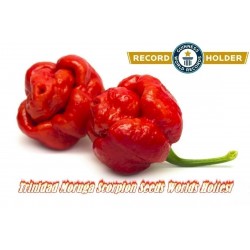
Trinidad Moruga Scorpion...
Cena
1,95 €
SKU: C 1 R
Seeds Gallery Com,
5/
5
<h2><strong>Trinidad Moruga Scorpion Seeds Worlds Hottest</strong></h2>
<h2><strong><span style="color:#ff0000;">Price for Package of 5, 10, 25 seeds.</span> </strong></h2>
<p><strong>As you can see yourself from our photos, that the seeds are from our own plants (organically grown) and you know what you will get from the seeds you buy from us...</strong></p>
<p>The Trinidad Moruga Scorpion (Capsicum Chinense), endemic to the district of Moruga in Trinidad and Tobago, is currently the world's hottest Chili pepper cultivar. The New Mexico State University's Chili Pepper Institute has identified the Trinidad Moruga Scorpion as the newest hottest chili pepper in the world as of February 2012. According to the New Mexico State University Chili Institute, the Trinidad Moruga Scorpion ranks as high as 2,009,231 SHU on the Scoville scale, making it the hottest chili pepper in the world to date.</p>
<p>Paul Bosland, a renowned chili pepper expert and director of the Chili Institute, said, "You take a bite. It doesn't seem so bad, and then it builds and it builds and it builds. So it is quite intense."</p>
<p>The golf ball-sized chili pepper scored the highest among a handful of chili cultivars reputed to be among the hottest in the world. Its mean heat topped more than 1.2 million units on the Scoville heat scale, while fruits from some individual plants reached 2 million heat units.</p>
<p>Leaving out the heat the Moruga Scorpion has a tender fruitlike flavor, which makes it a unique sweet-hot combination.</p>
<div><em><strong> Video:</strong></em> <span style="color:#0000ff;"><a href="http://www.youtube.com/watch?v=P2iWb6a8QD4" target="_blank" rel="noreferrer noopener"><span style="color:#0000ff;">http://www.youtube.com/watch?v=P2iWb6a8QD4</span></a></span></div>
<h3>Scoville ratings of peppers </h3>
<h3><strong><span style="color:#0000ff;"><a href="http://en.wikipedia.org/wiki/Trinidad_Moruga_Scorpion" target="_blank" rel="noreferrer noopener"><span style="color:#0000ff;">http://en.wikipedia.org/wiki/Trinidad_Moruga_Scorpion</span></a></span></strong></h3>
C 1 R


Bu bitki kış ve dona dayanıklıdır. Açıklamanın daha fazlaörneğine bakın.
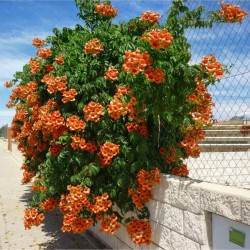
Trumpet vine or Trumpet...
Cena
1,95 €
SKU: F 45
Seeds Gallery Com,
5/
5
<!DOCTYPE html>
<html>
<head>
<meta http-equiv="Content-Type" content="text/html; charset=UTF-8" />
</head>
<body>
<h2><span style="font-size: 14pt;"><strong>Trumpet vine or Trumpet creeper Seeds (Campsis radicans)</strong></span></h2>
<h2><span style="color: #ff0000; font-size: 14pt;"><strong>Price for Package of 20 seeds.</strong></span></h2>
<p>Campsis radicans (trumpet vine or trumpet creeper, also known in North America as cow itch vine[citation needed] or hummingbird vine[citation needed]), is a species of flowering plant of the family Bignoniaceae, native to the eastern United States and naturalized in parts of the western United States as well as in Ontario, parts of Europe, and scattered locations in Latin America. Growing to 10 m (33 ft), it is a vigorous, deciduous woody vine, notable for its showy trumpet-shaped flowers. It inhabits woodlands and riverbanks, and is also a popular garden subject.</p>
<p><strong>Description</strong></p>
<p>The leaves are opposite, ovate, pinnate, 3–10 cm long, and emerald green when new, maturing into a dark green. The flowers come in terminal cymes of 4–12, orange to red in color with a yellowish throat, and generally appear after several months of warm weather.</p>
<p><strong>Ecology</strong></p>
<p>The flowers are very attractive to hummingbirds, and many types of birds like to nest in the dense foliage. The flowers are followed by large seed pods. As these mature, they dry and split. Hundreds of thin, brown, paper-like seeds are released. These are easily grown when stratified.</p>
<p>Etymology</p>
<p>The Latin specific epithet radicans means "with stems that take root".</p>
<p><strong>Garden history</strong></p>
<p>The flamboyant flowering of Campsis radicans made it obvious to even the least botanically-minded of the first English colonists in Virginia. Consequently the plant quickly made its way to England early in the 17th century. Its botanical parentage, as a hardy member of a mostly subtropical group, made its naming problematic: according to John Parkinson, the Virginia settlers were at first calling it a jasmine or a honeysuckle, and then a bellflower; he classed it in the genus Apocynum (dogbane). Joseph Pitton de Tournefort erected a catch-all genus Bignonia in 1700, from which it has since been extricated.</p>
<p><strong>Cultivation</strong></p>
<p>The vigor of the trumpet vine should not be underestimated. In warm weather, it puts out huge numbers of tendrils that grab onto every available surface, and eventually expand into heavy woody stems several centimeters in diameter. It grows well on arbors, fences, telephone poles, and trees, although it may dismember them in the process. Ruthless pruning is recommended. Outside of its native range this species has the potential to be highly invasive, even as far north as New England. The trumpet vine thrives in many places in southern Canada as well.</p>
<p>Away from summer heat, C. radicans is less profuse of flower. A larger-flowered hybrid 'Mme Galen' was introduced about 1889 by the Tagliabue nurserymen of Laniate near Milan.</p>
<p>The form C. radicans f. flava has gained the Royal Horticultural Society's Award of Garden Merit.</p>
</body>
</html>
F 45


Rusya'dan Çeşitli
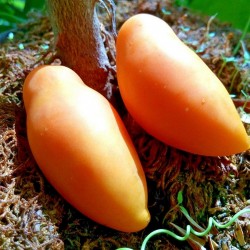
Tschuchloma Tomato Seeds
Cena
1,95 €
SKU: VT 84
Seeds Gallery Com,
5/
5
<h2 class=""><strong>Tschuchloma Tomato Seeds</strong></h2>
<h2><span style="color: #ff0000;"><strong>Price for Package of 10 seeds. </strong></span></h2>
<p><span>Tschuchloma tomato named after the Volga municipal Tschuchloma. The Chukhloma variety is considered as mid-season and the first ripe tomatoes can be harvested in 109-114 days. The plant gives about 12-15 fruits weighing 100-120 g each, orange elongated oval large (8-9 cm long) fruits with a slightly sour taste. Maturation from the middle of August, high growing (up to 2.5 m) good yield, prized trade sort from Russia.</span></p><script src="//cdn.public.n1ed.com/G3OMDFLT/widgets.js"></script>
VT 84 (10 S)

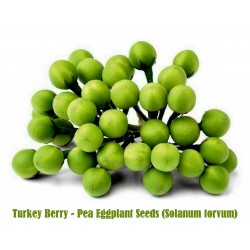
Turkey Berry - Pea Eggplant...
Cena
1,65 €
SKU: VT 168
Seeds Gallery Com,
5/
5
<h2><strong>Turkey Berry - Pea Eggplant Seeds (Solanum torvum)</strong></h2>
<h2 style="font-family: 'Helvetica Neue', Helvetica, Arial, sans-serif; color: #333333;"><span style="color: #ff0000;"><strong>Price for Package of 5 оr 10 seeds.</strong></span></h2>
<p>Solanum torvum is a bushy, erect and spiny perennial plant used horticulturally as a rootstock for eggplant. Grafted plants are very vigorous and tolerate diseases affecting the root system, thus allowing the crop to continue for a second year.</p>
<p>It is also known as turkey berry, prickly nightshade, shoo-shoo bush, wild eggplant, pea eggplant, pea aubergine, susumber ( Jamaica), boo, terongan, tekokak, berenjena cimarrona, berenjena de gallina, berenjena silvestre, tabacón, pendejera, tomatillo, bâtard balengène, zamorette, friega-platos, kudanekayi (Kannada: ಕುದನೆಕಾಯಿ), sundaikkai (Tamil: சுண்டைக்காய்),[3] (Malayalam: ചുണ്ട ), thibbatu (Sinhala), makhuea phuang (Thai: มะเขือพวง), suzume nasu (Japan: 雀茄子), jurubeba (Brazilian Portuguese), and many other names (Howard 1989, Little and others 1974, Pacific Island Ecosystems at Risk 2001).</p>
<p>The plant is usually 2 or 3 m in height and 2 cm in basal diameter, but may reach 5m in height and 8 cm in basal diameter. The shrub usually has a single stem at ground level, but it may branch on the lower stem. The stem bark is gray and nearly smooth with raised lenticels. The inner bark has a green layer over an ivory color (Little and others 1974). The plants examined by the author, growing on firm soil, had weak taproots and well-developed laterals. The roots are white. Foliage is confined to the growing twigs.</p>
<p>The twigs are gray-green and covered with star-shaped hairs. The spines are short and slightly curved and vary from thick throughout the plant, including the leaf midrib, to entirely absent. The leaves are opposite or one per node, broadly ovate with the border entire or deeply lobed. The petioles are 1 to 6 cm long and the blades are 7 to 23 by 5 to 18 cm and covered with short hairs. The flowers are white, tubular with 5 pointed lobes, and grouped in corymbiform cymes. They are shed soon after opening.</p>
<p>The fruits are berries that grow in clusters of tiny green spheres (ca. 1 cm in diameter) that look like green peas. They become yellow when fully ripe. They are thin-fleshed and contain numerous flat, round, brown seeds (Howard 1989, Liogier 1995, Little and others 1974).</p>
<p><strong>Range</strong></p>
<p>Turkey berry apparently is native from Florida and southern Alabama through the West Indies and from Mexico through Central America and South America through Brazil (Little and others 1974). Because of its rapid spread as a weed in disturbed lands, it is difficult to tell which populations are native and which are introduced. Turkey berry has been introduced and naturalized throughout tropical Africa, Asia, Australia, and the Pacific Islands including Hawaii, Guam, and American Samoa (Pacific Island Ecosystems at Risk 2001). In Jamaica this berry is called susumba, or gully beans, and is usually cooked in a dish along with saltfish and ackee. It is believed to be full of iron (it does have a strong iron like taste when eaten) and is consumed when one is low in iron.</p>
<p><strong>Ecology</strong></p>
<p>In Puerto Rico, turkey berry grows in upland sites that receive from about 1000 to 4000 mm of annual precipitation. It also grows in riparian zones in drier areas. Turkey berry grows on all types of moist, fertile soil at elevations from near sea level to almost 1,000 m in Puerto Rico (Little and others 1974) and 2,000 m in Papua New Guinea (Pacific Island Ecosystems at Risk 2001). Given an equal start after disturbance, turkey berry quickly overtops most herbs, grasses, and other shrubs. It grows best in full sunlight and does well in light shade or shade for part of the day, but cannot survive under a closed forest canopy. Turkey berry single plants, groups, and thickets are most frequently seen on roadsides, vacant lots, brushy pastures, recently abandoned farmland, landslides, and river banks.</p>
<p><strong>Reproduction</strong></p>
<p>Flowering and fruiting is continuous after the shrubs reach about 1 to 1.5 m in height. Ripe fruits collected in Puerto Rico averaged 1.308 + 0.052 g. Air dry seeds from these fruits weighed an average of 0.00935 g or 1,070,000 seeds/kg. These seeds were sown on commercial potting mix and 60 percent germinated between 13 and 106 days following sowing. The seedlings are common in recently disturbed ground. Frugivorous birds eat the fruits and spread the seeds (Pacific Island Ecosystems at Risk 2001). Turkey berry can be propagated vegetatively by placing branch cuttings, with or without leaves, in a mist chamber for one month (Badola and others 1993).</p>
<p><strong>Growth and management</strong></p>
<p>Turkey berry grows about 0.75 to 1.5 m in height per year. The species is not long-lived; most plants live about 2 years. Physical control of the shrub may be done by grubbing out the plants; lopping will not kill them. They can be killed by translocated herbicides applied to the leaves or the cut stumps (Pacific Island Ecosystems at Risk 2001).</p>
<p><strong>Cuisine</strong></p>
<p>The green fresh fruits are edible and used in Thai cuisine, as an ingredient in certain Thai curries or raw in certain Thai chili pastes (nam phrik).[4][5] They are also used in Lao cuisine (Royal Horticultural Society 2001) and Jamaican cuisine.[6] The fruits are incorporated into soups and sauces in the Côte d'Ivoire (Herzog and Gautier-Béguin 2001).</p>
<p>In Tamil Nadu, India, the fruit is consumed directly, or as cooked food like Sundaikkai Sambar, Sundaikkai Poriyal, Sundaikkai Aviyal & Sundaikkai Pulikulambu. After soaking in curd and drying, the final product is fried in oil as Sundaikkai vattral (available in all Tamil Nadu supermarkets), it is famous all around in Tamil Nadu. In siddha medicine one of the traditional systems of India Sundaivattral Choornam is used to improve digestion.</p>
<p><strong>Haitian Mythology</strong></p>
<p>This fruit is reportedly used in Haitian voodoo rituals.</p>
<p><strong>Chemistry</strong></p>
<p>Turkey berry contains a number of potentially pharmacologically active chemicals including the sapogenin steroid chlorogenin.</p>
<p>Aqueous extracts of turkey berry are lethal to mice by depressing the number of erythrocytes, leukocytes and platelets in their blood (Tapia and others 1996). A related chemical, cholecalciferol, is the active ingredient in a number of commercial rodenticides.</p>
<p>Extracts of the plant are reported to be useful in the treatment of hyperactivity, colds and cough, pimples, skin diseases, and leprosy.</p>
<p>Methyl caffeate, extracted from the fruit of S. torvum, shows an antidiabetic effect in streptozotocin-induced diabetic rats.</p>
<p>Cholinergic poisoning has been reported as a result of the consumption of Solanum torvum berries prepared in Jamaican dishes.</p>
<p> </p>
VT 168 (5 S)

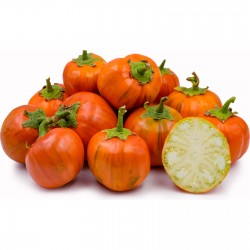
Turkish Orange Eggplant...
Cena
1,95 €
SKU: VE 96
Seeds Gallery Com,
5/
5
<h2><strong>Turkish Orange Eggplant Seeds (Solanum aethiopicum)</strong></h2>
<h2><span style="color: #ff0000;"><strong>Price for Package of 10 seeds.</strong></span></h2>
<p><i><b>Solanum aethiopicum</b></i>, the<span> </span><b>bitter tomato</b>,<span> </span><b>Ethiopian eggplant</b>, or<span> </span><b>nakati</b>, is a fruiting<span> </span>plant<span> </span>of the<span> </span>genus<span> </span><i>Solanum</i><span> </span>mainly found in<span> </span>Asia<span> </span>and Tropical<span> </span>Africa. It is also known as<span> </span><b>Ethiopian nightshade</b>,<span> </span><b>garden eggs</b>, and<span> </span><b>mock tomato</b>. It is a popular vegetable in north-east India, and is known as<span> </span><b>khamen akhaba</b><span> </span>in Manipuri and<span> </span><i>samtawk</i><span> </span>in<span> </span>Mizo. They are called<span> </span><i>Titay bii</i><span> </span>or simply<span> </span><i>bii</i><span> </span>in Darjeeling, Sikkim and Nepal and are relished with meat, particularly pork. These names are a result of its varied morphology, with ripe fruit often looking like a cross between an<span> </span>eggplant<span> </span>and a<span> </span>tomato, which are also from<span> </span><i>Solanum</i>. In fact, the Ethiopian eggplant was so much confused with the ordinary eggplant that this was considered by some a<span> </span>variety<span> </span><i>violaceum</i><span> </span>of<span> </span><i>S. aethiopicum</i>.</p>
<p>Ethiopian eggplant may have originated from the domestication of<span> </span><i>Solanum anguivi</i>. The<span> </span><b>scarlet eggplant</b>, also known as Gilo or<span> </span><i>jiló</i>, was long held to be a distinct species (<i>S. gilo</i>) but is nowadays generally considered to be a<span> </span>cultivar<span> </span>group of<span> </span><i>S. aethiopicum</i>.</p>
<h2><span class="mw-headline" id="Uses">Uses</span></h2>
<p>The leaves of<span> </span><i>Solanum aethiopicum</i><span> </span>are eaten as a<span> </span>leaf vegetable<span> </span>and are actually more nutritious than the<span> </span>fruit.</p>
<p>The highly variable fruit of the plant is eaten both raw and cooked and is becoming more popular as a cultivated crop. These fruits are usually harvested while still green, before the skin becomes thick. The bitterness depends on the levels of<span> </span>saponin<span> </span>it contains, some with a sweet flavor and others very bitter. When the berries mature, they turn bright red because of high<span> </span>carotene<span> </span>content.</p>
<p><i>Solanum aethiopicum</i><span> </span>is used as an ornamental in Asia.</p>
<p>In Nigeria, Igbo people use it as a substitute for kolanut especially for those who do not want to chew kolanut. In which case it is used to welcome guests at home or before resumption of a traditional ceremony.</p>
<p>Garden egg as it is commonly known in Nigeria is sometimes used to make a tomato based sauce which can be used to eat yam</p>
<h3><span class="mw-headline" id="Cultivation">Cultivation</span></h3>
<div class="thumb tright">
<div class="thumbinner"><img alt="" src="https://upload.wikimedia.org/wikipedia/commons/thumb/4/4c/Solanum_aethiopicum_MS_2264.JPG/220px-Solanum_aethiopicum_MS_2264.JPG" width="220" height="147" class="thumbimage" />
<div class="thumbcaption">
<div class="magnify"></div>
Fruit of<span> </span><i>S. aethiopicum</i><span> </span>from SW Burkina Faso</div>
</div>
</div>
<p>Currently there is a large movement towards increased cultivation of<span> </span><i>Solanum aethiopicum</i><span> </span>in West Africa. It grows all year long and can produce high fruit yields. However, low germination rates are an obstacle to wider cultivation.</p>
<div class="thumb tright">
<div class="thumbinner"><img alt="" src="https://upload.wikimedia.org/wikipedia/commons/thumb/e/e8/Bitter_tomato_raw.jpg/220px-Bitter_tomato_raw.jpg" width="220" height="293" class="thumbimage" />
<div class="thumbcaption">
<div class="magnify"></div>
Fruits of bitter tomato ready for cooking in northeast India</div>
</div>
</div>
<p>The only place where<span> </span><i>S. aethiopicum</i><span> </span>is grown to a significant extent in Europe lies in South Italy, to be precise in<span> </span>Rotonda<span> </span>in the<span> </span>Basilicata, where this plant is of some commercial importance. Probably it was introduced by veterans returning from East Africa after the colonial war in the late 19th century.</p>
<div class="thumb tright">
<div class="thumbinner"><img alt="" src="https://upload.wikimedia.org/wikipedia/commons/thumb/f/f3/Chicken-Bitter-Tomato.jpg/220px-Chicken-Bitter-Tomato.jpg" width="220" height="215" class="thumbimage" />
<div class="thumbcaption">
<div class="magnify"></div>
Chicken cooked with bitter tomato in northeast India</div>
</div>
</div>
<h3><span class="mw-headline" id="Selected_cultivars">Selected cultivars</span></h3>
<ul>
<li>'Turkish Orange' or 'Turkish Italian'</li>
</ul>
<dl>
<dd>The fruits of this variety are about two inches in diameter and turn bright orange-red when ripe, although they are usually eaten when still green. The sweet taste is often used in<span> </span>Thai curry. It can produce fruit within just 75 days after planting.</dd>
</dl>
<ul>
<li>'Sweet Red'</li>
</ul>
<dl>
<dd>These striped fruits, just 1 inch in diameter, have a strong but non-bitter flavor. The plant is thornless and grows up to 3 feet tall and can produce fruit 125 days after planting.</dd>
</dl>
<ul>
<li>'Small Ruffled Red', 'Red Ruffles', or 'Hmong Red'</li>
</ul>
<dl>
<dd>The two-inch berries of the 'Hmong Red' have deep creases and a bitter flavor used in Southeast Asian cooking. It can produce fruit 100 days after planting.</dd>
</dl>
VE 96 (10 S)

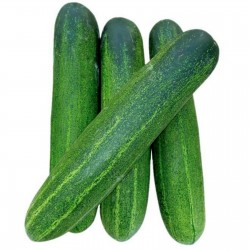
Typhoon Cucumber Seeds
Cena
1,75 €
SKU: PK 28
Seeds Gallery Com,
5/
5
<!DOCTYPE html>
<html>
<head>
<meta http-equiv="Content-Type" content="text/html; charset=UTF-8" />
</head>
<body>
<h2><strong>Typhoon Cucumber Seeds</strong></h2>
<h2><span style="color: #ff0000;"><strong>Price for Package of 30-40 (1g) seeds.</strong></span></h2>
<p>Typhoon is one of the favorite varieties of cucumbers for salads in Serbia. Typhoon salad cucumber has a vegetation length from sprouting to harvesting the firstfruits for about 45 days.</p>
<p>The fruit is elongated and cylindrical in shape, smooth, dark green in color with light stripes, about 17 to 20 cm long and about 4 cm wide.</p>
<p>The average weight of the fruit is 180-200 g.</p>
<p>Plants are tolerant to late blight.</p>
</body>
</html>
PK 28 (1g)


Sırbistan'dan Çeşitli

Ta roślina ma gigantyczne owoce
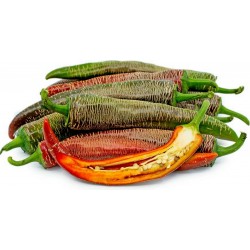
Vezanka Chili Seeds Old...
Cena
1,95 €
SKU: C 57
Seeds Gallery Com,
5/
5
<h2 class=""><strong>"Vezanka" Chili Seeds Old Serbian variety</strong></h2>
<h2><span style="color: #ff0000;"><strong>Price for Package of 10 or 50 seeds.</strong></span></h2>
<div><span><strong><em>Vezanka, Vezena</em> </strong>peppers are medium to large in size and are long, slender, and taper to a point at the non-stem end, averaging one centimeter in diameter near the stem cap and 15-30 centimeters in length. The pods have prominent, horizontal tan lines, also known as corking, and these lines create a leathery texture. The skin matures from green to red and is very thin, moist, and slightly chewy. Inside the pod, there is a hollow seed cavity housing many round, pale white to cream-colored seeds that are slippery, firm, and crunchy. Vezena peppers have a mild to medium heat, are very aromatic, and are initially sweet with a nutty finish. </span>
<h2>Current Facts</h2>
<span>Vezena peppers, botanically classified as Capsicum annuum, are a rare heirloom variety native to Eastern Europe that grows on small plants reaching just under one meter in height. Also known as the Rezha Macedonian pepper, Vezeni Piperki, Vezenka, Vezanka, and Vezhenka, the name Vezena Piperka often translates to “engraved” or “embroidered,” a descriptor used to identify the pepper’s unique corked skin. Vezena peppers vary considerably in heat and average between 1,200-5,000 units on the Scoville Heat Scale, with some peppers carrying less capsaicin having a milder taste and some peppers carrying stronger heat similar to jalapeno. Vezena peppers are commonly used as decoration and are also dried and ground for use in spices such as paprika. </span><br>
<h2>Nutritional Value</h2>
<span>Vezena peppers contain vitamins C, A, K, and B6, potassium, manganese, iron, magnesium, copper, and fiber. </span><br>
<h2>Applications</h2>
<span>Vezena peppers are best suited for both raw and cooked applications such as grilling and roasting. They can be chopped, diced, and incorporated into salsas or they can be roasted or boiled and used in marmalades and spreads. Vezena peppers are also commonly dried and hung for extended use or ground into paprika and chile salt. They can also be pickled or smoked for an added flavor. Vezena peppers pair well with savory foods, omelets, onion, garlic, sour cream, yogurt, meats such as poultry, pork, beef, and fish, creamy sauces, rice, potatoes, goulash, and boiled or steamed vegetables. They will keep up to one week when stored in a paper bag in the crisper drawer of the refrigerator. Vezena peppers have extremely thin skin and will dry out quickly if left in a dry, warm environment. </span><br>
<h2>Ethnic/Cultural Info</h2>
<span>In Serbia, Vezena peppers are often hung in large clusters around homes and are dried naturally in the autumn sun. The peppers are then left as decoration or are used for grinding into spices and powders. Vezena peppers have been grown in Serbia for hundreds of years, and the Serbian farmers search for the fruits with the most corking striations and collect the seeds as these peppers are considered the most valuable to grow. </span><br>
<h2>Geography/History</h2>
<span>Vezena peppers are native to Eastern Europe, specifically to Serbia. The exact origins are unknown, but these peppers are believed to have been cultivated for hundreds of years and are also found in Albania, Yugoslavia, and other select areas in the Balkan region.</span></div>
<script src="//cdn.public.n1ed.com/G3OMDFLT/widgets.js"></script>
C 57 (10 S)


Peru'dan Çeşitli

Ta roślina ma gigantyczne owoce
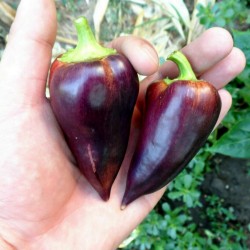
Violet Sparkle Sweet Pepper...
Cena
1,95 €
SKU: P 40
Seeds Gallery Com,
5/
5
<h2><strong>Violet Sparkle Sweet Pepper Seeds</strong></h2>
<h2><span style="color: #ff0000;"><strong>Price for Package of 5 seeds.</strong></span></h2>
<p>Pointed, wedge-shaped fruit is purple streaked with pale yellow. We originally received a few seeds of this variety from a Russian seed trader. Ripens red. Very lovely and delicious, sweet, crisp and thick-walled. One of the finest and prettiest peppers we have tried!</p>
<p>The flavor is excellent: sweet and aromatic, but you must wait until the peppers fully mature; they are very bland in immature stages. Wait until they are red and orange. I loved watching these peppers grow and their color change as they matured. They aren't just gorgeous in the purple stage they also turn yellow, orange, red with beautiful streaking and different color patterns when in-between colors.</p>
P 40 (5 S)

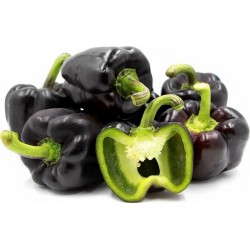
VIOLETTA Violet pepper Seeds
Cena
2,00 €
SKU: PP 41
Seeds Gallery Com,
5/
5
<div id="idTab1" class="rte">
<h2><strong><em><span style="text-decoration:underline;">VIOLETTA Violet pepper Seeds</span></em></strong></h2>
<h3><span style="color:#ff0000;"><strong>Price for Package of 8 seeds.</strong></span></h3>
<p>Violetta is a thick-fleshed block pepper coming in 3 different colors. These peppers weigh 250 g (0,6 lbs) each and start from violet, then turn green and then finally red. They appear riper, the sweeter. Violetta can be grown outdoors in warm areas or in greenhouses.</p>
<p>Capsicum annuum </p>
<p>Harvest: from August</p>
<p>Plant height:</p>
<p>outdoors: 70 cm (28 in)</p>
<p>indoors: more than 70 cm (28 in)</p>
</div>
PP 41 (8 S)



